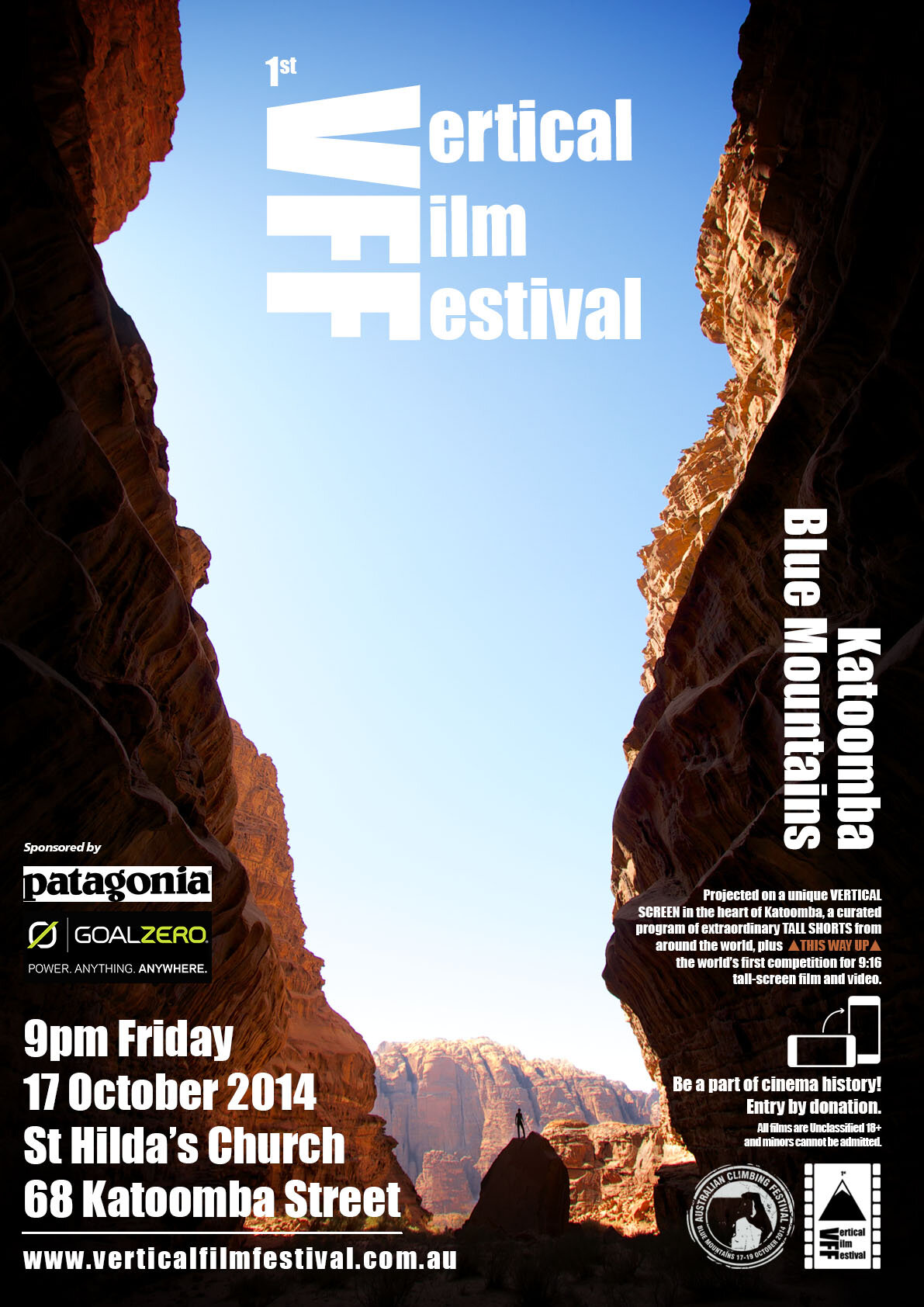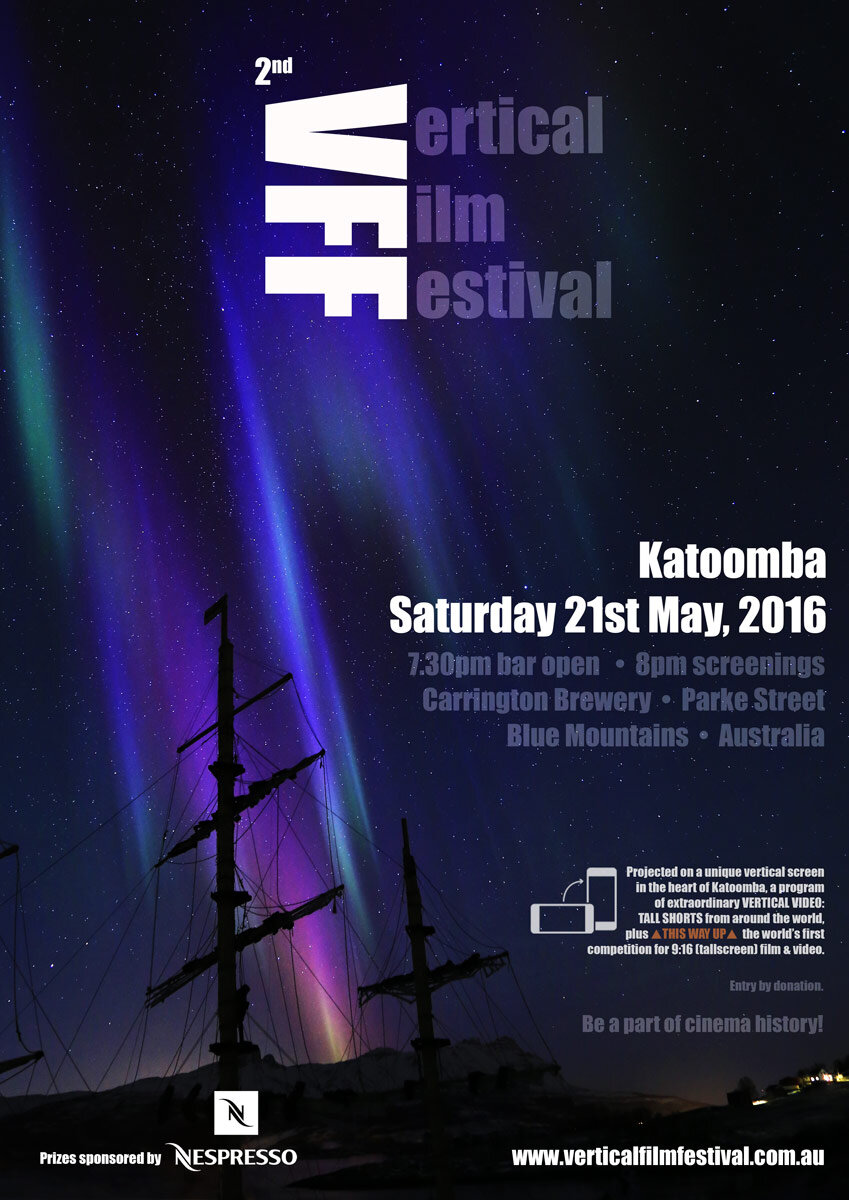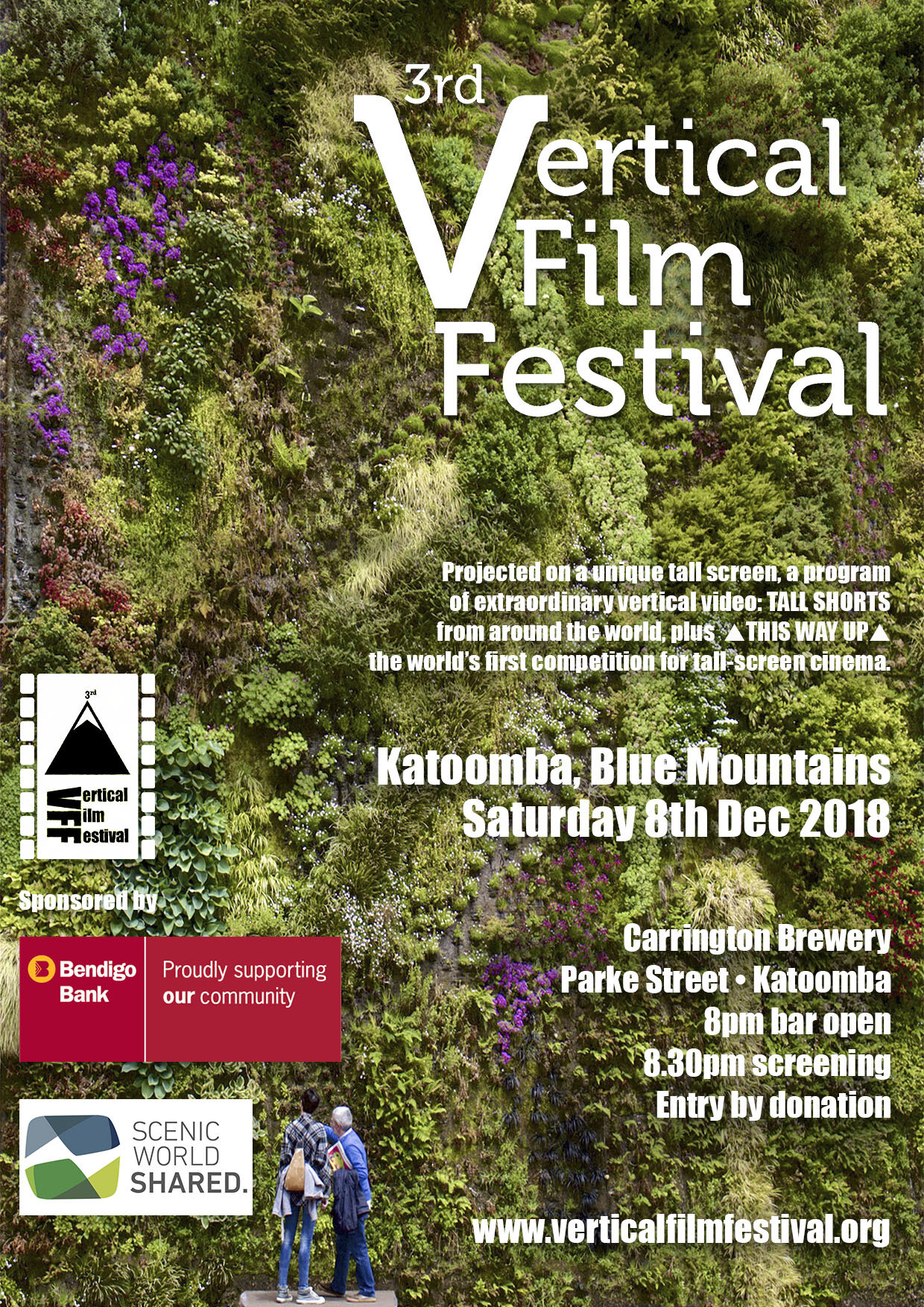►ABOUT | FILMS\SCREENINGS | NEWS | VERTICAL VIDEO TIPS
UPDATE (MAY 2020)
Regrettably we’ve had to make a decision not to run the 4th edition of our biennial Festival (which was scheduled for Q4.2020) due to the Covid-19 pandemic. No new date has been set. More information is found in our news blog.
ABOUT THE FESTIVAL
Vertical films and videos are flourishing as new types of cameras and screens easily allow people to shoot and view non-traditional formats. Now’s the perfect time to explore the creative possibilities of tall screens!
The Vertical Film Festival (VFF) was established in 2014 as the world’s first international competition for vertical videos: short films created and edited portrait orientation (9:16) for tall-screen projection in front of an audience. Regardless of theme or genre, the VFF is a showcase for artist-filmmakers who are exploring the creative potential of the vertical format while its visual language is still taking shape.
We are a non-profit organisation based in Australia, run by and for filmmakers. The 3rd edition of the Vertical Film Festival took place on Saturday, 8 December 2018 in Katoomba.
The 1st edition of the Vertical Film Festival was projected on a tall screen in St Hilda's Church, Katoomba in Australia's Blue Mountains on 17 October 2014. Photo by Adam Sébire. (CC BY 3.0 AU)
ABOUT THE FESTIVAL
Vertical films and videos are flourishing as new types of cameras and screens easily allow people to shoot and view non-traditional formats. So now’s the time to explore the creative possibilities of tall screens.
The Vertical Film Festival (VFF) was established in 2014 as the world’s first international competition for vertical videos: short films created and edited portrait orientation (9:16) for tall-screen projection in front of an audience. Regardless of theme or genre, the VFF is a showcase for artist-filmmakers who are exploring the creative potential of the vertical format while its visual language is still taking shape.
We are a non-profit organisation based in Australia, run by and for filmmakers. The 3rd edition of the Vertical Film Festival took place on Saturday, 8 December 2018 in Katoomba.
The Festival comprises an out-of-competition section called TALL SHORTS (featuring a curated collection of the best vertical cinema from around the world) plus a vertical video competition for works 3 minutes and under, ⇧ THIS WAY UP ⇧
The VFF encourages filmmakers to create and submit works that explore the aesthetic potential of the vertical format, on any subject matter. Films can be created on any apparatus that produces HD quality or better, be it smartphone, film camera or computer. If you’re a filmmaker, get some tips for vertical filmmaking here.
Prizes are presented at the end of each Festival screening. You can watch some of the films we screened at previous editions in 2018, 2016 and 2014.
A BRIEF HISTORY OF ASPECT RATIO
(PROGRAM NOTE FROM THE FIRST
VERTICAL FILM FESTIVAL, 17 October 2014):
We’re delighted to welcome you to the 1st Vertical Film Festival here in St Hilda’s Church tonight. Not only because it’s a beautiful space, but because vertical screens trace their lineage from the stained glass windows that in church architecture so eloquently suggest transcendence.
Till the advent of cinema most visual art didn't conform to any one orientation or aspect ratio. Vertical framing had tended to dominate Asian art as well as pre-Renaissance European art, but subsequently, paintings came in all shapes and sizes. Some paintings escaped the frame altogether in the form of frescoes, while the camera obscura had been delivering circular moving images for millennia. So why should the so-called 'seventh art’ insist on such standardisation?
The battles fought over screen geometry as cinema developed in the early 1900s are little-known but left behind a plethora of curious historical formats. Indeed the intrusion of a new optical soundtrack onto the filmstrip pushed cinema's width-to-height ratio close to square at one point (Fritz Lang’s 1931 film M was 1.19:1 for example). Faced with multitudinous formats, Hollywood engineers of the Academy of Motion Picture Arts & Sciences met in 1930, determined to set a new standard.
There, only Russian filmmaker-theorist Sergei Eisenstein argued against standardising the landscape format — he saw the horizontal rectangle as a throwback to the theatrical proscenium. Addressing the Academy he argued passionately for the possibilities of "the dynamic square”, calling for cinema to remain flexible to a variety of geometries. Despite cheekily advocating the “virility” and evolutionary superiority of vertical screen forms, he lost the argument to the studios’ commercial imperatives. Academy Ratio (1.375:1) was established in 1932 and endured until cinema’s battles with television pushed film formats wider again in the pursuit of crowd-pleasing, field-of-view-filling immersiveness.
Many filmmaker-artists equated that immersiveness with audience passivity and in the 1960s the Expanded Cinema movement rebelled against the movie ‘industry'. Some attempted critiques of the hidden power structures of cinema, whilst others searched for cinematic environments that might inspire ‘oceanic consciousness’ — it was the 60s after all! Both camps sought to free audiences from the ’tyranny’ of fixed spectators passively receiving a singular, horizontally rectangular perspective on the world — using installations or projections onto domes, sculptural objects, and multiple screens of varying geometries to do so. Such ‘expanded' cinema was to be experienced kinaesthetically, with the whole body, not just one’s eyes and ears.
In today’s digital era, camera standards remain yet there are fewer limitations on what can be delivered. Chasing ever-higher definition, the televisual medium has settled on 16:9, devised as an average of pre-existing screen ratios. Yet a digital video can be anything from 1 pixel high by 1 pixel wide (form an orderly queue now for the 1st Pixel Film Festival!) Even the rectangularity of screens is set to become passé.
As screen devices become more and more ubiquitous in our lives they also become more portable, and hence flippable. Device ergonomics and human physiology encourage us to hold most mobile screens in a predominantly vertical orientation. Many such devices have tiny gyroscopes to flag which way up their user is creating and viewing content. Vimeo, Facebook, YouTube et al. look at these flags to allow vertical videos to be embedded the right way up; only their display (without annoying black bars or ‘pillar-boxing') remains a sticking point. The era of Eisenstein’s flexible screens is well and truly upon us; it just hasn’t been converted into a business model … yet. So vertical filmmaking is likely here for the long run — well, until holography eliminates the frame altogether…
Tonight's Festival, in setting few limits other than duration and orientation, has thrown open the door to see what comes in. As the first worldwide competition for short vertical videos, it’s been fascinating to see tall-screen climbing videos mixing cheek-by-jowl with experimental cinema, animations, documentaries, and even iPhone videos. Several works shown tonight, such as Oscar-nominated The Numberlys sit at the nexus between apps and videos. In common, all our filmmakers are quite clearly revelling in being able to view the world from another perspective.
To closed-minded naysayers on the ‘net — and there are plenty — 9:16 vertical videos must be the result of a mistake, something to be ridiculed. “Try shooting it properly next time,” they sniff. True vertical creators shun such dogma by composing their shots with the vertical frame in mind. To do so they have to overcome the problems of apparatus designed for capturing, editing and screening horizontal images. (Even the manual for the Festival’s HD projector includes a surly warning from the manufacturer never to turn it on its side lest it overheat!) But in surmounting these challenges they’ve become cinema’s latest pioneers. Ultimately the filmmaker's choice of whether to make a horizontal, vertical, circular or square film should purely be determined by their subject matter and what we’re trying to say. Cinema is arguably at its most powerful not when attempting widescreen immersivity but when it's offering alternative visions of our world — and vertical video can, in the right hands, do just that.
So, thank you too for taking the leap and making a little bit of cinema history with us here in Katoomba. We’re honoured that so many filmmakers have allowed us to show you their work here tonight.
With a bit of luck the projector might even make it to the end without incident.
Adam Sébire
Festival Director
Blue Mountains, Australia, 17 October 2014
(revised September 2018)



The dizzying Labyrinth Project at Montréal’s Expo67.
WHO WE ARE
The Festival is run biennially on a voluntary, not-for-profit basis. For its 1st edition, the VFF was held under the auspices of the Australian Climbing Festival.
The Festival is founded and co-directed by two graduates of the Australian Film, Television and Radio School (AFTRS): Adam Sebire, a filmmaker/cameraman/video artist with numerous broadcast, art exhibition and film festival credits, in collaboration with his sister Natasha Sebire, adventure filmmaker/cinematographer and co-organiser of the 2014 Australian Climbing Festival. Natasha's film Resounding Silence was selected for the Banff Film Festival, 2013.








